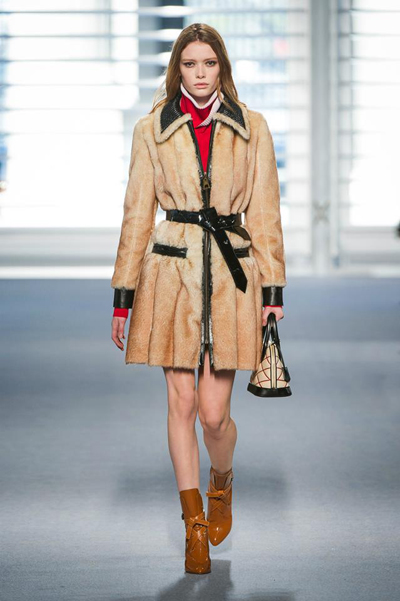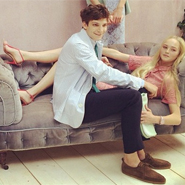British fashion label Burberry saw the largest growth in brand value among luxury brands this past year, according to a new report from Millward Brown.
Luxury brands in general saw a 16 percent rise in brand value in 2014, compared to a 6 percent rise from the year-ago period. This was the steepest rise since the recession, with the combined brand value totaling $111 billion.
"I think after any recession, there’s a little bit of a lag when it comes to luxury because the first categories that people bought were things that needed to be replaced, like white goods and consumer electronics," said Oscar Yuan, vice president at Millward Brown Optimor, New York.
"2014 is the first year a lot of the replenishable goods have been replaced, and people are looking to the luxury goods," he said.
For the ninth annual WPP BrandZ Top 100 Most Valuable Global Brands report, Millward Brown conducted 150,000 interviews with consumers. Millward Brown Optimor also looked at the companies’ financials to determine their value.
For the purpose of these rankings, luxury was defined as high-end clothing, leather goods, fragrances, accessories and watches.
Perception and profits
Louis Vuitton topped the rankings in the luxury category, with a brand value of $25.873 billion. This was a 14 percent growth from the previous year.

Louis Vuitton fall 2014 collection
Hermès, Gucci and Prada followed, with Gucci’s brand value making the largest jump of the three at 27 percent.
Representing jewelry, Rolex and Cartier sit at five and six, with Cartier’s brand value rising 40 percent over the year-ago.

Cartier ad from Robb Report
Some consumers still see a label as a means of personal expression, with 50 percent of Chinese and 48 percent of United Arab Emirates consumers saying they equated the two.
Burberry came in at eighth, with Fendi at tenth. Fendi saw a 17 percent drop in brand value, coming out at around $3 billion.
On the top 100 list in all categories, Louis Vuitton was ranked thirtieth, with BMW close behind at 32. Hermès and Mercedes-Benz came in at 41 and 42 respectively.

BMW i8
These ranking are important because they point to a brand's potential, since brand is the differentiating factor between two different products, according to Mr. Yuan.
Consumers are more willing to spend on jewelry than in previous years, and are inclined to purchase items that are purely decorative and show off their personality. This trend shifted into handbags, where brands chose to make items that did not overtly display their logos.
Luxury brands in general decreased their products aimed at aspirational consumers, leaning back toward exclusivity. Instead of making a lot of logo key chains and small items for sale, the brands are now looking to their fragrance lines to reach entry-level consumers.
Burberry chose not to offer promotional pricing on its rainwear and leather goods, choosing instead to focus on maintaining its exclusivity.

Burberry Shanghai flagship
One of the top things brands need to be aware of is to make their brand experience seamless across physical and digital mediums. Brands are embracing social media more, but they need to be sure that it matches the image they have created.
Luxury brands should also work to narrow their audience and pricing scales to protect their positioning.
At the same time, being too narrow-minded about social media and digital is not a good strategy, and Millward Brown suggests embracing these forms of communication to reach a global audience.
Luxury tends to focus heavily on emerging markets, but brands need to not forget the consumers in more traditional markets, where there are large audiences of potential consumers.
To increase desirability, brands should think of providing something different from their competitors. The brands that are successful are often described by consumers as “sexy,” “successful” and “premium.”
"It’s constantly coming up with something new and different, and constantly delighting consumers," Mr. Yuan said. "The whole point is to keep the brand fresh and new in consumers’ minds."
Clear leader
Other studies have also found that Louis Vuitton is still on top in consumers’ minds.
Contrary to the notion that big name fashion labels are losing their luster among Chinese consumers, a new study from ContactLab finds that Louis Vuitton is at the top of the list for brand awareness.
In a test of unprompted brand awareness, which measured the number of times that consumers in the study named the label’s name spontaneously, Louis Vuitton had twice as many mentions per 100 participants than its closest followers, Chanel and Gucci. Compared to more established luxury markets, such as New York, the Shanghai consumer is less sophisticated, not familiar with as many brands and more centered on mega brands (see story).
Last year's Top 100 Most Valuable Global Brands report showed some of the same trends.
Louis Vuitton remained the world’s most valuable luxury fashion or jewelry brand, but Prada’s value rose more than any other brand at 63 percent year-over-year, while the French fashion house’s declined, according to the BrandZ Top 100 list from Millward Brown.
Both Prada and Kering-owned Gucci are new to the BrandZ Top 100 Most Valuable Global Brands report this year and each saw notable gains due to sales increases in key global markets, especially among Asian consumers at home and abroad. Ranked separately from luxury apparel, accessories and jewelry brands, the world’s most valuable luxury brand is BMW, which fell to No. 2 in the automotive category due to the slowdown in Europe (see story).
"The first five were the same top five as last year," Mr. Yuan said. "What it says is that the luxury market is quite stable.
"It’s an interesting observation given how quickly things in luxury change."
Final Take
Sarah Jones, editorial assistant on Luxury Daily, New York
{"ct":"njLkPQ8n4onJT+2jq48Zv59V9ZomGl2hVo7NZtnVMH15mopmniHDI9kR3aSIyvmtsyPbFOvvRmAZ\/xSoeg8XsGmzKH\/Fi8uqczxl9n5tXXnjnm7E5y1rGoARqh9dyDkn\/Vvru+XaSehN++jNUD3kvabYSTt\/NIppudigytHS8sPHuEHYznqF9e1Kjm5mUooTPUMIErxmF3\/zBn\/h3qBjcg0UwhRyj+YJZuAfyPvoFovr+ImbvPzT95C\/hZdV77hAYs5g9PQYPHf7EKVtU0jWiGVCOzlKyLCDlNzogvtPUD7nO8QMJBiux9vhZp5k7COV3mL118KjO1MlXFR1QJNHVDhwUtSt6omtAS9kCQJHZ7hMQhgiEtq5h56aMIUf9rpwAoTNn5Krmst9D1TnUkoHuBOko4iRfYkL4otaTgzdvab3GUOb2VuMjNHAz8fUj5aUuwD\/qkr6pfQHTx4yOT2546PTLV\/HtPJlGaBvOjIwe1DzqNrJ03Wq+y7uvxGKhW\/3Gpzd9qLHBPeGSqTL5bqGkzPDL9qgGNhsLaqGcfLdsN1sOei3oL6bOyWsNPEkUnPc4aR0CbUMmcaq9VFwz\/0d4kfm6vGT4iSLEmSEnSvcs2BqQ0lCyJGzRYIrjhu0N0dhgLp7f9K8kcHg2QWHI56MdFsWNkY2js+1HvfoK+xwxkAo0xO8KehydJVYBh1avC+KQx4fWNwo32lq+\/+XJzATkDfJ7jwPIVJSPviBS+05aJanfhehAOaK4hKvx9OGunOIKWFjBrq2mNC\/XKa4qKQlKzZ70wFnF3VjTGO2S7uwhYqkJ1wb6ZK9\/w5DegilIJ7RGMFigiMSWMrYv8XazlgWRUy6zoJ12qUc0TZOTwQvgBWR5i5zXkazZy7tqFAw5E5N76MYYVEmoGGGRF\/ShKeAE5Q9QxXpPf00CTqsEXEB+2nUnpwnHNfkdyAH010eUDoohYEW8Q0JARxFtLpjJUlFtT34OJrNriHEyeZ\/dfZAIc02KF2iSffNa76KGl84a3an8YvQ+HaJq3ExMR2tU81jARok9AqN9I6zjKOl0M1fQ4+UnZFCfBF8nlnUJ9mcoUzisxEUOYPfLvyJIIUYn1bBOTQO5cwsCh5Thm1sS+FqM0CdFKL8xZ1lqf51LkiY8HBaLGSSkohiiRAnC1wClN3biSXtzD5jlosXY7RR2uTO0GHL8v\/RSHMlc8VwL2hxwRnUpRrlkXGwqNmJiYT5ykGPDAvI3uunvqnoWM+pE2wRZuPQU2A+j9b0pou7ayCf5K9CUzh9wLk4Kg4U91Kp9L0VUMR1+jaEWfBlrdxEN+UdY84eQDRqYJD3vszZdlSBVFUdTyefVs1saLq51R4kTqvy3mUdWm5kpTmdEjR6qpHEahGV+2Jl0BZVnD\/uE2Vhg6A\/19lw5ksNPzex6F8pBcJK7Ba8ocVTGrYzNfEshT23oTxqGw8n4DqIBFk0W8o+RUEhLcH5nnVGTYqtLK5K55vj7uFJitBtW7TiY2IKw6delZOfbA0hKh9XOF45Gngf2RlxIL5RQsHnFGUIxJSLLjMWHQzm3cjcH7kXz4D1eeZjOf7OpQhvc6Slb\/0B35z3g1gl3BdxnN8QQ2EYvymLmfUHxkQH1moG3Im5DJMhuQeWnm3M8rcUsMPM1BQ6q43eBwJe4E8xH5LzotitKCGXqj6wO4YKLbC2pkZ7jzCKIZ2BF96u\/SvR6Zw+ClBKGXIpGFVx5EnqOs3q3c+f9kUA6Yfsye5IJx6DetqXbiYVCiCqpZk14sfjwQGRlRiXetpfxLoEBSqt+1hSgST+ciGB\/6xgFDIsswy9x1FPmwTiKqC7M8eAZR2CNBuERYr0oiO8taaXxq2rrLzvY4CKwc4Ps1GJnJ+ZvjTv30bvIjGfRIr+tXHo\/kNoQB5koaN+WmedS2bPJe6B0CrrBH7BlssDmRdTZmZDdP45XyMbh+PbKtKL6q9Dgb7vbzrHGxwF0GH2+fHEPt2+r1k25VlhLpwM87g99zBfPB20o8ezEpa3HKEUkJh166DH2Dw\/5drTJuFg1nZxJoYzkNKZ3\/DF5SHnN2WCzIE2cIq8ggccw\/LCeIDiqJyNCPtH4ZcsYFAMSn8Bz2iRzbQofpA7fsNrp4ek3UlyiG7YtzPfu29dvvfs6aLozfR1HF2rq78JxsE+WVb6Y8pdMfA5D4Y2VjgZY0kDERgl\/d0w6SCdx5g9G\/1uHI4gi6e8nfst3FabLzNXvZkxB3x2GxZWd0RxAXlrQRRKo5\/7Je09UTix8e7DenpWsSy1ot7Zo955f90nhwWqaHJeiH3eZprIJM3k\/Ol4A\/J0Nvtz8CKuMjfYgJN7Vd1z+qKHKscAO2YEuXivMf4\/vGrwMbYUMTv6YuSx+Gj67vhe+qx5T19LKY6+Cw4IHzEwg7FhLcvhtt3RiIkNDnexIrAj09pzdf0uKFZPtJt19bW7\/F6+LOCSJGUWnSjDZ\/9D5PgTSPunjbgLKkslkd84IgwK2dm71e9\/fVErcp7AS4U0SCIuOB0vYkSf2OKo15FP\/hGuW5YX6M73hLKi1yUlFssMIfAPm718ca3dUkj4Dy78zqYPndylF4EVXyaWY+Ei71AKoXeEdNc\/DcUae2CxESM6ClBwe+PMsMTRAiiTfW24WN2ZbUco3IKNiJGuCwIeFQDTy5Q5asA4hsUlbEcS\/F7ILhJzC+xamoRyIXMWwo3+4x\/hea04qagff75uiBT8nScrgxt8J8GB8QAzWPIaHFI5IJIKNYklyORdhP0bWAOek58lAwHNqWiHGKmZ98K4ycNHsnvOTQu5As+X\/sux4BefnE5\/5YHYE0xbYpqJkbUjwTKB7qjTVjiUF\/rFpYF0FunRBlJgHnTNNO+\/Ip9vCmNMMSPcCXvCuilTtlMh9+\/zgZvEk2a3uve0BYS6oHpXBCViocH5phbVXZ7QOOSQPjyo4cpH43Z+n9YzQVnnYvqlW\/1Rs+TZGh2+DOSOGtTlXqsA8ki+8h5C+N0YrS601ra5Sltzn11brk8tMDri4vA2Ny\/I2rD2nmz3JUU7qQK3mfBmymWEoD\/DJYvVb3aAwUH3K4kCefKBXyyDKwuG8LK8hgudgPiJp\/vhxeSJlovq4GJTTbaf8wWbkBSre1Zu0lWjwct3JxyZwWM\/qSrxRY\/DMJuvz\/x9eJJKQaP\/X8\/fadrh1sy2awMBVl4zoHq2K9sO+9AkKZm1u6Ae\/9mxhLTzSeaD07oRPXZn7WOo7\/SKv80bDWVYGPIq93IwZnAZoS9n0DE6eUT3TY5ssh8iCB08+8y5giyO+gjuqQdziblZiZx2vy4otVhtClT0fXSrSKk\/1NQCPBF6ijk0pqmxqylFMjXl9F1vsZiECg+JxIkYFp4db8aMwbuetV16nKiVRId2cYidtOywS+cvXtehmIzdbFzs2FI1+iWw2aoJ7fxhek\/dsH2OAyVV4W1WE9bFCj1WJVrCeW2o5roSJcBnTd6ySyXodcYYmCIeGl8BPCZ\/uE9jb8O01HGDyIKLcNOYx1MOhiuNmRPowyuX6JOsqG1IXJ0ixoEnr5cNpXKxB4vPgx9d\/k+qnPHJ2CQrnT4do2yTM7zl0Ghvg+7LfjO5Xljr9HZsQay+1wg4Q6lKrzAsIXPOpAJi\/OGcB8iSgJ9AJZqx+qtIdbcMer\/\/irnmJa25jra5+iVu3tYlPakbKkWlNyrKKehcPA3NxzCKb8Wu95FF1xEev0PK71qoPpxNMZBZX8RzqW0zIlZs72ZXh1FiAD\/oLohrn1lCwXaSqNIPDH+0JyiFeHs4tSyNaA5ERjaZ3RVCj6LiJRqIQHztfIbH8wuQCE\/puP2qgHS0h+lnKI1wk+DVwzS1sPqJZe06i66AuINds9cE6yJfEhwwPVQJANGmJrnCsOTEoQnNE+HlQOgNb7SAYJMMV9LEaSDd7lYXMltpxOaYIKJFqBWoV5mdz3NXoY8wd+Pg5LijW8AFa\/sRf0Z8ilxAgSnJf1r7H13a0mgKtmHaoeE8u5iPvMSl1RlsJ9qIb+cBZgst2YJwN0N+Ja2FU7fQ8qMAvKLP4fNz0GlW1nFMQLSCMkISwtOgDV5hEv8mup\/8LMcdWNRYYFjC05\/OAt2OkCduLhlaslRvLwoItSN8urR6gx5WKE2eL1KZRx13+JcEOyF3Uvq+g9xBTrljdhFO0vHswerC92lZrTGLwvsZ4OaSXzLdtV9vueKu3bp+sYjQXP9cIZq32euYJa\/N8oE4DnT5o+wv+be\/LRExJc6cUdl7zit0U3247sNsMZG+t6KpJq\/EDWSh5bi1NOza8gYvpedRajW7MomhXxjyRXyQiPFR2oixZv2LdZdMVmj9idnPGCmXi56qyiny7XX8stnWJtFluvBIQc\/OjNQzZJ1XkNoOGgo9eZaXIhD4Tzvk1VTaemTjF\/iPTRvrZO7T8wop\/Oec0xL1UNWt1PLAKJITB+n0b6Sa3Cw8IjqAOla3Sf8zH67maogDdLS5ryCXsiSDcfxLWfKrAIqV3SccYqBZ+2fpn+F6LBbiAgT4PBaOv0422zdF+shTvytrCBf32eVHv8xRbsXsIqHj0PlJrgKzaJcVAc5CE5MiNbqzjGP9PQQgu5k+YP\/z2BhEy2IERc6J4tS70dZEogQc+xwjIO9s4biw3YMh9gW41YRJh0PRWoMoZVZxnTOg+pzvwfiXB67Wi5HVAlwsDYKT6viM3yrQxIA9TYD996JGwf2zgbOikswURtHbJg6JP0Vc6+X9rcYAKWFoD8D0pgTIYjVfPhifQBB4bI+1sw2pHPWBu\/x\/fN17M2XZzrr9JkVlHFz2RNd9YS64wNRrmeLVY+E2hINUz\/VsN0Q1w8a6y78e0cst5Q935AbyxvMvbwYaV5I76Pfm21u4XUjYjNFvpV7+nb8NICHbU+H8XvzMSkSZVBa9Pp1NlzoflaN3ejeszyupy3MJF7aqqklVJ9pzIbBRB8KCrMlcL5rwusTakb5\/a4oEbaaeJXNkjK2dhx9CnnorjI8cAAaRbIEvwQkJ6MtrROazPpTlHLx9YhhCBfRyC75wlLCadG5l7GXH2+g7ib91nZsVqfyNMMZPa01j98Ch4bvejpVGooF+PVkabgLjkB3XIOSgMDql+oEFE6VPmFCweQn6ySBwecn4JWSX5NLq+9KI4NGc3q2S5c0pYkPpkW\/LOURBGVbBvfzuzft4jOLMLCpgSXe96im9mG+MaKiwZTpauN3YX3TH\/f0SvkYlXojdpZ9Tm1KTNXVZT94YPg17i4Rt9zuMLS1jyjk9M+PwILlCGDbdyww2Uo5R4rtfSP\/Vn58T5MtLb7J15eGTUnp+Qo6zQ52N4P2a+Xi+jlN5J5sKQDtYQuz\/AOeWTZurp+ixaeeG0U\/Wl2TtGnLCVOlm2HsPHwfC7mggwGXHeYPHBgF7UJ1AiMjxci7hxcYjw+KaXA7Yfv+5HlJ7TSxYqGKZ5dml1hBAQpH7zL\/zCOGwCld1ZtkXGH6gPh\/\/hoP09JLUZDyU5O1CSzkioyXzYjSKm7Qp1iI2UwL0wQ3kaGPjbOTcmTUZTXYf3zyp8jJqkzUSpTzQxuwwrilUvGyGhM\/5ANxWgxjgzKMU6YRb0dWot9vuJZRqnKTvrPFyMURzql3lXKNtkCkXtVlI3MXMn8fJeekDJDsZtm6zcY2oTCXResGsWD6NaRgq07C6gidJCbopBHYmuJUIiikla3XxfQg2hghSZz+c+pOdHTR8Zffqp3V7u+X0Bf8S7AsTUypsrl0dtUSPcarVD2awfqe+HpBI7P2rvgIqnyYQOv1bc3hpYVrSCGQDCjiycdoGayOCp8VlzpjTSrJ0+mU\/GbuTiXbKIx86FSqm9dhGs7nQEWk3Ij4couAwD5dSUg\/HFdkKUh9Wd3xtXU58y+0q9sB6wRm1HFYKKtanVhRrFTgEbJjBgf5NNRfCshBP8+\/6WKRC+vA3PlpwdIy8ZPCzyL9mWNrKzwj0WmdVmoB4vluzs2kfJds3FpCkqS+yT\/gDxl4kPShUsrOw\/o9QbbKnMKXyuYv+nVRevSnMUl\/nOMr63ykew3JSme6sAlWANTSweAkG4Hvn\/3nnoBCLTXLALKYiUX\/t9lPGY9Unlig7Bngx7iVEbeUBWawopL88JZvV9L5\/2OUKy3vhWP\/bXgsdw9qYnPIkH0ZRYG+V3utI37lOr0hMjhaVm3Sfe+ZtYxXTjGsk0iHEvWcY3QIMC80eY\/MjuA8CdoFEHH6zvtsDtFafpi9\/MCi7AqfG7G2lLbZNmRP2Gv4UjuLjGsQsL5Vh\/6YuvFrHYmJ5wiNkh8bzxjStRcQzXHJMSCW3iUu+tl9NtIQZNr\/j0HOeU+L9G2AUAM\/k06YOYKElmxi+pkXZXt+LAFzkEMOPBVOeGI5h4BcW6nMtQMiYcG6FpaR7AitgPCrwSvIl8ZVi6lG7Wg0suEDru0TsaxfJQtaMbtuztcnwBwB\/LWU4+Ml3xaRaLaeHs+Wwh5UXsSEfm6SqzXji\/xQRZU5lTECXkHYpRhsy\/Gd8aEYFVbWw28rYp\/riosOzAesuRrd445tThjJd\/OBHXZfuzS60mAvrqEJU6r6W\/d5WuWcoY\/KZ2OCdv9qyoT4lagFjDKVcRryubzZwZcVNqovXb4EuZviZRUBAhEBCgtyc23A6Uq3vcuoSnpnYZ9t3uFFES8tPigc4\/h2h\/8XBrIxScyU2wFhjpMSA449zt1JUUQCtxRAolkpKnX+AVY\/dhw5FwCOlW13TjqbsJToD0WdjOatrVaxXBJO+ZN+FFpuurMfZFrsHeLKG7hYiQbKxPM3ErJyBAmf+M\/ykxDQ0HRfzNqXQqqD9\/TSYkVeP6NRMylS8RZnFOC6Rvy7P9kHZgy1Cw9c9Zo2Iz25mOYKXWn70GszwGKRKQo17DxPUsxAXpQht+XtKRe35iO3qZYCwPQg5adepSZhD6zF07haxzPlEnS\/5cCrHsvPHe9V08SoxiYHVgZfEMFtcYmFCT6xhrPDMaC5XxS9T2OwYy4b0dhOeWaZVqdTf8w\/2Ls1whv8nVfrU1cxZLMO6hoVDVbI30P1Uchdn55BUyVxDshUaqb3DtjRYQLb3nQb2Cl6ZXTTgwu7EmhiO9QFvUvjb9IYFwFgCvaUR9k1jPwnKw8Fcv9uck7M2hevelYQEem\/q4wq+91vhslqHTGuFdYDnpa9EiHygWSsSYhjJzf2riJoHcy5yzh7qEtPKKi4UB6ZBUIlTRfFI7FNFm+PxTSsBPwL1d+K6HwunIzYKh+s+C4g15ABFUPuQ3c1F9GpQyw1cMjH7T6R0D6EpCyRtu22uS8EpUp+ysRjo+EcGjUIBBQcYP+qK6FUkTNwWCkbvzvGP6ExGIoS4rJM70WKTN1LRnLrCsB9kNHPXxPlj9cHszhOTsPDtkRtPaQnw2fT1CbcMunfQ1Gq+oNgN0ltSgg3vka1hHbvy1b9wc+veBXAoAUueSUSqB+seZ2mZf5879CAcWKTbaj\/nw0WSebl1C0ZadjygUaNME4+Pl6jgm696uN3\/arI3DEad6wByUxBWnjHQvm8l8sfk9\/OEbHdvstaEUOrvK78o6+rmuFcnhOgdgPodLr5T7E1EqiD1+0rhsApw2WGhOCJIIGDQDJLen0U7AzhX8mTZWqYGdCm7zzNNXOu5F0G9+9M5i55ZaUO46BQ71lE8mFkM47m+f9RuPQLhZk9gLDYfvgc0Abin4usAImnCnCIg1Kq\/o2t8OREvwL4w7bGIFWT8i2BCflM\/VFDUVqFpn3AX04Bp\/7NA71K4ZxVfMeoYk3PEvaAFEj3XUHg2oi2AKjQ5X0ttzIaxdnUZxBm\/NztIw1uAtACqMQHy1yYyZ2SKXLpvrWogDgDjTBjhY904mKnoBvSA8Hb3oRH\/pRJy2w1cbpgdYRVr6knIwyvgT4823tipCorGUYaYtuzljB61pfWcVvKkIk+XJzKIyd0ZOTY66DcyS3\/OMsyvfP3BoIJW59fRGtTInyjqZ0gZnhgVBlIed7rlFP561liefcQ3qg7RMiGlvRvsGYfthDFYj\/BkKIew0DB6WZqsH7wRRBASRiofbJj1uASGhJomZdW4tgj0lN7CB2TesyrANjOkgCAofHq8evHVVVrNZ3GKrYbCN\/3YDqImQKFnfw2Cv0+wZYst96JzFI3WaHZvL2JCB3Qy55qcVrtL8WDBPd9420ZNzXJU0hT+EoETEjKtAF5EDzLVBX0lPj8uuWa2aC9Nb8nnllvLDq59AZ7PLqQUGRh+7jzHVvRW15WHNB0kzTVvhY9cAHLZYqI0yGS6ROAMVvnm\/Cp9CW4dqUvBI6AAHtHWms7KBsxyyi5b+QJlv6cnU269rFFoiQe6f5jPp2KDjlH\/cG6Pt5IYlH0tjSZicR0bzT6dZiHTsIRWL1EQ5TIHRhx1dRmk5bXZpScoqPz5dXlWmrfVzR\/Bm23hIGYF6KpC+0SlMrAfn8ySvOstS4\/lFDfXaPHRnnh3sxUlgbjsMUttIVbFOKPXhH6hpqJ+xabLXpBIai92R3hSFp+KkTYc21TWurJUWr3SFzMvOKjMiWYeveQhIQcV1sLMc0lAGSfovjIKCyp+Z1nlHRFYdm6EZv62XoEvLoN+GstVGrSsBzXIZW+gcYecBlbHlVYsVWJqQl6kLGvBziB5\/na9v5PYKXPhCZd106NxPKTaHpA6qZHujmKG6YXGoxo82jyKoNrXlJhK9SR3RvOa1W88UkgmlU6h9yD39a4HQZ3dtK7YrPR95ZD5HgPcwnUBaIYVV3HIvBogxrki0M\/Xvcar+RIqqrxdzVoXRUdERVimYkuTfO71ns19PUTUzTXkHc+ASX\/SUV+SjOT581NlA1mjdb1SqJ9isXpnG5nlS9YyOcOgA75mlVXn99dcJ9u5ajdUKCYFCqqHiFaTOv1hMRZAujD1E+MSONg+BwdfJ4XAdFz+tYHlqFuH27IGaoJgjwtuTF4b8ykBeYX9d4aHiff18FPRB+69o2LDcLkKm32ccQvGR9FbUMXhEcUy+VDN\/ZUYCUCDTlermZeUUaAPVmZkeMmKGURPtG+RWO2xyHBxv+DXQqvtlr2HpxK1YCE\/HBgVo67GNlPXNlwH7MDAVjq5+KVS4BDAn1+yOfx4JXNU3bFgstKZxr+U\/7JaVWvGoVhC\/hZOBXQocf6E4P9HavezJFB0l0h2Y+J4sNCdIXn7IGkJV7wC8sUbuvJ0CJbFtIQwwEWn\/8+XEMMOAJs\/k8KmrXd+bbqayuyGV6o8nt2DQlkjTLmgzbqfPbnyofdpM8fdQb1Ptt57VXywkDw+PY5BG+xRGSQSxJUYiiaSlV1CT7gFAuN0T1WcmvI0z\/uf99GiCYUKVTARYuuI3uaajCZ0GjG3DvlN85Q7mZgyQU\/rDEyHRauXMatSKzrc9tuu64W6t0x7d1jEvg0fAt3io6Tm2o7q2w0ohC6V+GpPYwJQe6gsnJBD0TCwZhzKVvCoT0E3CA05UZ1s5cGbsQqcRlW56Zs81e5eYuxpsOskuHRTNLP1SeaGFtSBU8\/6y8ez1qVcuUOHfqPFuKdoIi1TxTJsOCmg3RjYPzs465xJDh\/d236TUZ9kbDzqYPgY1Zf24ox2utD94tBg1z9D\/yEmwpo2fq5ZUMBKYH2pVpdPhUiVI2nd+cZPpr3TF+h6A\/I5CZ1j7IAksL+3MaIm5+smjtM5ANl7K9K+CL8sWI0C+SMbQdTn\/Sf0iTM7NJ87YINBIRDOIKF0VVfXe0TNSTzmNHYX\/\/a7F6G13VEAasSKYCjBJjbTOwyFgT9UBaUVS5piaXd0i\/K2mlPmjsrDzGFvWGPzFZl44tiyxR+cU9bCVnRqGCrSUZxy9ygGIvL6nYV4rd6uqKyuQjzsu3lZlVZh4O7HIOSv7oe80dTluduqtlHZpVICjmNx6ZBpBEh9m\/oYwOoX8q7sFxBvsEVymBLv2aANSjQDr6iyzv7uC+O+kodKm\/jeMJb\/yawy2C7gs27nQzXJEg2oB3WvCNmi0aXMbjbDwsKDesdaYm4HNzd7frfPSfY4mbjHwMu0qmINbRsGxhP7wMIJsbEistUFoFelsSOAzFoBEyXpgHH7xb0+3Wv9SyDe5tuRBEnw8kVnIHtYz5VRJGzKFU7P2BJm6EVaFmZKcNJOETtnQ23nRdiJ\/Ut42BZWlQkgbL+dJfH8VIVJcCSGV1aue851fvAOV\/oLZ8UCE26zBQYgdmrfyICWvxZk26z9M+zU8qTwuf+vkapeRISmBRRMPe+MHIUF28TPVTcVA03WCvyssBlBaeDQ1dWBvESJH+ddbmO79Sk7UPrUk4linuEwJr5OTeWdQY23CfO4xHvC5pyVbVl\/x5bpXBNg5f6gBloHqZrge5jgv1QEVGSpUvZCbbuwc9IEtpWARLPnv3I0Miv83B9Tjp7v3nWsyWb9felngjFpCbOrDRAXg3mImUnvSzK2v+UzVPOhBqAFBB00Ub8Ub61l2ynFVB3Lg6yiBR5Gdn8ibEdPTMyx\/iH2iZ5Dp9ZoyodyqJ3CSIbgQsye4q05qQVCmXcwJh89Jo+eKsQQjZHbAw0t93gNAZeXZpkd6OP4yTwJtOHa0l11Vno9a0VGxxXl5yKfzZygl+KJfIVytuFmUnEM2ypIJl1tZRLbbF1O5Ps7zpJnMwvSXkXwxMPjomrAaTzamuYuhc8AAGvFOWg4W8q4dxxIwet21P4xporIvswoSNWXBEuaTdI93hVjjFsjKAza3F0uXTY1ZrMwiFmUJLQtOic6L9vyTX\/Bmnlajo3ckbvxuMp\/xR\/zYweBffszaPoqIq\/I+EsQ+ggIVBbRT7Q+Z2GQSOgnAMv9mJ1FWX01ov6aagipq992NPySzEzYoAc++SzqyBCA0oTkGLytDc8rVIjVvfR27Hev\/mi\/Tnl75tNuoqwW5MoWDEXsOwY15zj1OaB1pWmSZyb3JXxH8bG2mny3GIQQwBJlRoau6FgeiI5cReQvSTX6K7lCIblgPLlMKi7oSAb+ztaWPH72dwf8fa9d1EIYaipZzXOqFs05H1KgnKGfDi\/uK23YKUh1KQ16K9y9PxGRQIfOfLq27m1HwWH53QOvp\/Up4RBMaFuvu5GpSYmx4rajLUOSkujzdoxcN7akRg6cjPPMYMiNf9STAp57LKlnzPu2zuFkDUbCOcRD\/7VcqVkZNKnT3kAJEUC2pvCbBOJrWKkxesQllSYmLpvvzMspT0BpWEsxH+CFBtmPqThWVmGa1aaFHWk4dBxJNDDYVPkD7yXfS49QSg4m3INvVKInWBliXevJbgxMIvxjEr3VRkUlm8uIBcNmb5PXK3NYPmNQbGAxEHcp6UiaINlOAp7yCiKjteuX6ZU=","iv":"dd2aaab3af2d7194b4c65bfae74d9eb6","s":"1dcb95d052d17789"}

 Behind-the-scenes of Burberry's spring 2014 campaign
Behind-the-scenes of Burberry's spring 2014 campaign